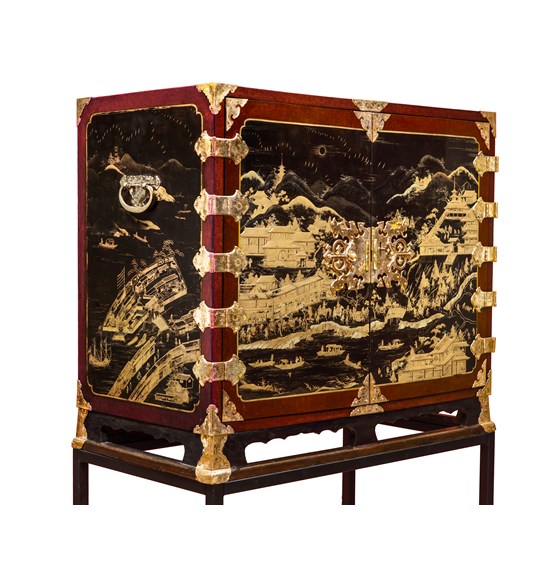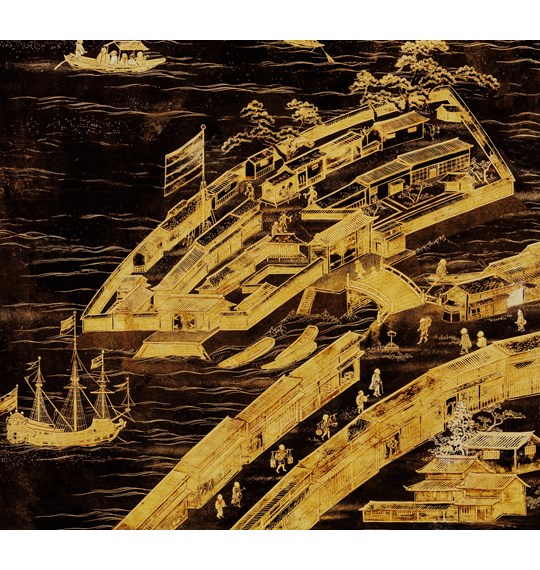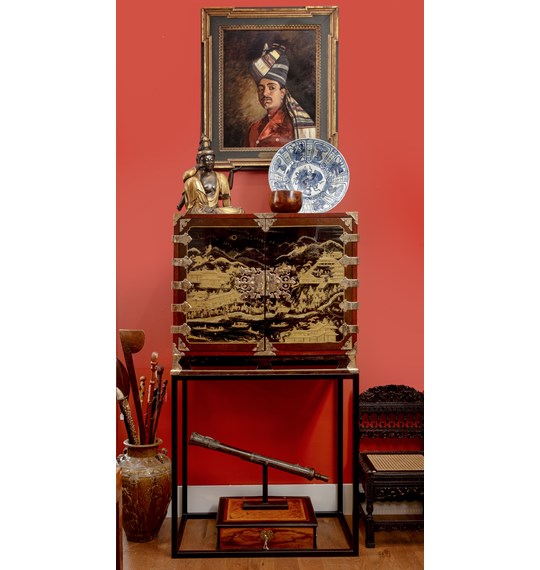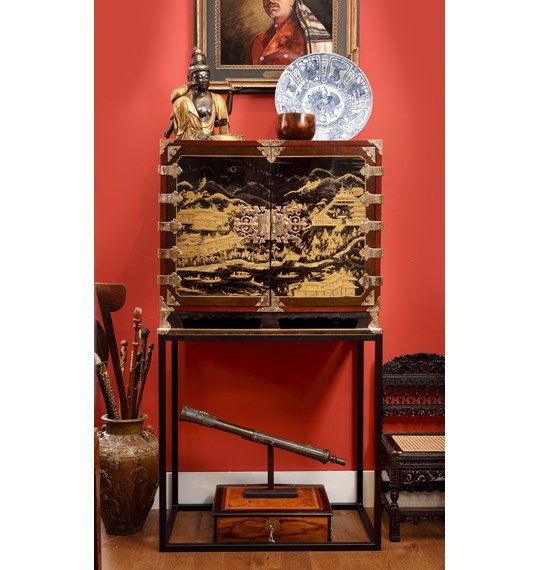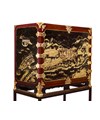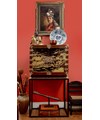Furniture-late, Furniture-early, Objets d`art, Oriental and Asian Art, Highlights
description
A Japanese export lacquer cabinet with depiction of Deshima for the Dutch market with gilt copper mounts
Edo period, circa 1660-1680
H. 88 x W. 100.5 x D. 54 cm
The sides and front of the rectangular two-door cabinet are embellished in gold and silver hiramaki-e and takamaki-e on a black roiro lacquer ground with a continuous design. The two doors depict a long procession of numerous figures travelling on foot and horseback along buildings and a pagoda into a mountainous landscape. This is the annual court journey, Hofreis, of the Dutch from Nagasaki to the Shogun’s court in Edo. Three horseback riders are dressed as Dutch merchants and a fourth figure, probably het Opperhoofd, is seen inside a palanquin, norimon. Just about to cross the bridge, two men are carrying a cabinet like the present one.
Many Japanese figures on either side of the procession are engaged in various activities; some play musical instruments on board of small boats, others are fishing; figures inside buildings are depicted playing go, and farmers are tending to their rice paddocks. The upper part of the right door shows a large mansion, probably the local daimyo’s castle, with men kneeling before a man in the central courtyard.
The court journey fits in with the foreign policy of the shogunate which accorded a role to the VOC alongside China, Korea, and the Ryukyu Islands who also had to pay tribute. However, the VOC employees were traders, having low status in Japan’s social hierarchy, and they were received with less deference than were the state embassies from Korea and the Ryukyu Islands. Nevertheless, the contacts with the Dutch were a welcome source of information to the Shogun about Europe and European science and technology.
The left side of the cabinet depicts, in mirror image, a rare view of the artificial fan-shaped Deshima Island, the trading post for the Dutch in Japan. The island, where the Dutch flag flies, is surrounded by small Japanese boats and an anchored three-masted fluyt (cargo ship), flying Dutch flags, with on the stern the VOC monogram. On the bottom right a busy street of Nagasaki is shown, bordered by shops and leading up to the stone bridge. On the island the trees are beautifully painted, two cows can be seen, and the flagpole, all in very fine detail. Dutchmen and enslaved Malay are visible outside the buildings and two Japanese figures, probably guards, sit in a small hut in the centre.
A maximum of fifteen to twenty Dutchmen lived on the island at any time and soldiers or women were not allowed. Restrictions on Deshima were tight, and the merchants were only allowed to leave the island by special permission. The Opperhoofd had to be replaced every year, and each new Opperhoofd had to make a court journey to pay tribute, present gifts, and to obtain permission to Margaret Barclay eep on trading. In the distance, many birds fly above the hills and a four-story pagoda can be seen. The right side of the cabinet is painted with other horse riders and their retinue journeying through mountains.
The pair of doors to the front open to reveal ten rectangular drawers. The drawers are decorated with scenes of birds in flight and landscapes with trees and plants. The reverse of the left door with two thatched buildings, one with a ladder, underneath a camelia tree with large blooms; the right door with a three-story pagoda nestled among trees and both doors with a flying phoenix, ho-oo bird. The cabinet, with elaborately engraved gilt copper mounts, hinges, lock plates and brass handles, is raised on an 18th-century English japanned wood stand.
A pair of large cabinets (H. 109 x W. 117 x D. 73 cm) with eighteen drawers behind the front doors, instead of the ten in the present cabinet, is in the Dutch Royal Collection presently in palace Huis ten Bosch in The Hague (access no. HtB 01190). Among the largest known, these two beautiful cabinets can be dated around 1660-1680. The subject of the decorations on these cabinets is the same as on the present cabinet; the procession of the Dutch, with the Opperhoofd in a sedan chair, norimon, carried by four bearers, the scribe, or head secretary, and the trading post physician, accompanied by a large entourage of Japanese officials and servants, leaving Deshima Island on the court journey to the Shogun in Edo. The Royal pair of cabinets depicts the procession of the Dutch in mirror image; one shows the departure of the procession from Deshima Island going from left to right, and the other the same procession going from right to left.
These two cabinets were first inventoried in 1684 when they belonged to Princess Albertina Agnes (1634-1696), daughter of Stadtholder Frederik Hendrik (1584-1647) and Amalia van Solms (1602-1675). They were part of the furnishings of Albertina’s castle Oranienstein in Dietz, Germany. This pair, which must have been very expensive, was probably a gift by the VOC to her mother Amalia - although no sources prove this. However, it would be unlikely for the VOC to present the sixth daughter of Amalia, who lived in Germany with such an exuberant gift. It is known that the VOC gifted Amalia about 20 years earlier a bed of state fence in fine lacquer, of which in 2021 we discovered one intact baluster (now in the Rijksmuseum, object no. BK-2021-18). Albertina Agnes in 1652 married her second cousin Willem Frederik van Nassau-Dietz, Stadtholder of Friesland, Groningen and Drenthe, and the ancestor of the present Dutch Royal family.
A fourth cabinet depicting Deshima and the procession of the Dutch on their court journey to Edo is in the Musée des Beaux-Arts, Dijon (inv. 3550-6) and was exhibited in the exhibition ‘Asia in Amsterdam, the culture of luxury in the Golden Age’ in the Rijksmuseum, 17 October
2015 – 17 January 2016, and in the Peabody Essex Museum, 27 February – 5 June 2016 (cat.no. 9 in the exhibition catalogue, edited by Karina H. Corrigan, Jan van Campen, and Femke Diericks with Janet C. Blyberg, for the exhibitions in the Rijksmuseum and the Peabody Essex Museum). This cabinet is not covered in black lacquer but in transparent lacquer with gold and silver hiramaki-e and takamaki-e lacquer, gold foil and copper mounts, and is dated between 1665 and 1685. The landscape on the doors is dominated by Mount Fuji in silver maki-e, which in its original non-oxidized state would clearly have shown the snow-clad mountain top. On the right side of the cabinet is the procession of the Dutch on their annual court journey to pay their respect to the Shogun in Edo. The left side of the cabinet shows the Dutch trading post on Deshima in the port of Nagasaki.
The present cabinet and the one in the Musée des Beaux- Arts in Dijon must have been ordered by or for a high-ranking VOC official at about the same time the two cabinets in the Royal Collection were commissioned, most likely by the Amsterdam VOC Chamber.
The present cabinet is slightly smaller than the Royal pair of cabinets and the Musée des Beaux-Arts one but arguably is finer in detail.
Provenance:
English private collection formerly at Cliff Avenue, Cromer, Norfolk, since the 1950s and thence by descent.
By repute purchased by the family from Margaret Jane Barclay (1861- 1958) of Herne Close, Cromer, together with the entire contents of her house. An album with watercolours by Margaret Barclay was found in the cabinet.
Margaret’s ancestor James Barclay (1708-1766), established Barclay’s banking dynasty. The cabinet was likely purchased by Margaret’s father, Joseph Gurney Barclay (1816-1898), who built Herne Close as a holiday house and furnished it. Joseph was one of the wealthiest members of the Barclay family, leaving many properties and a fortune to his children after his death.
Edo period, circa 1660-1680
H. 88 x W. 100.5 x D. 54 cm
The sides and front of the rectangular two-door cabinet are embellished in gold and silver hiramaki-e and takamaki-e on a black roiro lacquer ground with a continuous design. The two doors depict a long procession of numerous figures travelling on foot and horseback along buildings and a pagoda into a mountainous landscape. This is the annual court journey, Hofreis, of the Dutch from Nagasaki to the Shogun’s court in Edo. Three horseback riders are dressed as Dutch merchants and a fourth figure, probably het Opperhoofd, is seen inside a palanquin, norimon. Just about to cross the bridge, two men are carrying a cabinet like the present one.
Many Japanese figures on either side of the procession are engaged in various activities; some play musical instruments on board of small boats, others are fishing; figures inside buildings are depicted playing go, and farmers are tending to their rice paddocks. The upper part of the right door shows a large mansion, probably the local daimyo’s castle, with men kneeling before a man in the central courtyard.
The court journey fits in with the foreign policy of the shogunate which accorded a role to the VOC alongside China, Korea, and the Ryukyu Islands who also had to pay tribute. However, the VOC employees were traders, having low status in Japan’s social hierarchy, and they were received with less deference than were the state embassies from Korea and the Ryukyu Islands. Nevertheless, the contacts with the Dutch were a welcome source of information to the Shogun about Europe and European science and technology.
The left side of the cabinet depicts, in mirror image, a rare view of the artificial fan-shaped Deshima Island, the trading post for the Dutch in Japan. The island, where the Dutch flag flies, is surrounded by small Japanese boats and an anchored three-masted fluyt (cargo ship), flying Dutch flags, with on the stern the VOC monogram. On the bottom right a busy street of Nagasaki is shown, bordered by shops and leading up to the stone bridge. On the island the trees are beautifully painted, two cows can be seen, and the flagpole, all in very fine detail. Dutchmen and enslaved Malay are visible outside the buildings and two Japanese figures, probably guards, sit in a small hut in the centre.
A maximum of fifteen to twenty Dutchmen lived on the island at any time and soldiers or women were not allowed. Restrictions on Deshima were tight, and the merchants were only allowed to leave the island by special permission. The Opperhoofd had to be replaced every year, and each new Opperhoofd had to make a court journey to pay tribute, present gifts, and to obtain permission to Margaret Barclay eep on trading. In the distance, many birds fly above the hills and a four-story pagoda can be seen. The right side of the cabinet is painted with other horse riders and their retinue journeying through mountains.
The pair of doors to the front open to reveal ten rectangular drawers. The drawers are decorated with scenes of birds in flight and landscapes with trees and plants. The reverse of the left door with two thatched buildings, one with a ladder, underneath a camelia tree with large blooms; the right door with a three-story pagoda nestled among trees and both doors with a flying phoenix, ho-oo bird. The cabinet, with elaborately engraved gilt copper mounts, hinges, lock plates and brass handles, is raised on an 18th-century English japanned wood stand.
A pair of large cabinets (H. 109 x W. 117 x D. 73 cm) with eighteen drawers behind the front doors, instead of the ten in the present cabinet, is in the Dutch Royal Collection presently in palace Huis ten Bosch in The Hague (access no. HtB 01190). Among the largest known, these two beautiful cabinets can be dated around 1660-1680. The subject of the decorations on these cabinets is the same as on the present cabinet; the procession of the Dutch, with the Opperhoofd in a sedan chair, norimon, carried by four bearers, the scribe, or head secretary, and the trading post physician, accompanied by a large entourage of Japanese officials and servants, leaving Deshima Island on the court journey to the Shogun in Edo. The Royal pair of cabinets depicts the procession of the Dutch in mirror image; one shows the departure of the procession from Deshima Island going from left to right, and the other the same procession going from right to left.
These two cabinets were first inventoried in 1684 when they belonged to Princess Albertina Agnes (1634-1696), daughter of Stadtholder Frederik Hendrik (1584-1647) and Amalia van Solms (1602-1675). They were part of the furnishings of Albertina’s castle Oranienstein in Dietz, Germany. This pair, which must have been very expensive, was probably a gift by the VOC to her mother Amalia - although no sources prove this. However, it would be unlikely for the VOC to present the sixth daughter of Amalia, who lived in Germany with such an exuberant gift. It is known that the VOC gifted Amalia about 20 years earlier a bed of state fence in fine lacquer, of which in 2021 we discovered one intact baluster (now in the Rijksmuseum, object no. BK-2021-18). Albertina Agnes in 1652 married her second cousin Willem Frederik van Nassau-Dietz, Stadtholder of Friesland, Groningen and Drenthe, and the ancestor of the present Dutch Royal family.
A fourth cabinet depicting Deshima and the procession of the Dutch on their court journey to Edo is in the Musée des Beaux-Arts, Dijon (inv. 3550-6) and was exhibited in the exhibition ‘Asia in Amsterdam, the culture of luxury in the Golden Age’ in the Rijksmuseum, 17 October
2015 – 17 January 2016, and in the Peabody Essex Museum, 27 February – 5 June 2016 (cat.no. 9 in the exhibition catalogue, edited by Karina H. Corrigan, Jan van Campen, and Femke Diericks with Janet C. Blyberg, for the exhibitions in the Rijksmuseum and the Peabody Essex Museum). This cabinet is not covered in black lacquer but in transparent lacquer with gold and silver hiramaki-e and takamaki-e lacquer, gold foil and copper mounts, and is dated between 1665 and 1685. The landscape on the doors is dominated by Mount Fuji in silver maki-e, which in its original non-oxidized state would clearly have shown the snow-clad mountain top. On the right side of the cabinet is the procession of the Dutch on their annual court journey to pay their respect to the Shogun in Edo. The left side of the cabinet shows the Dutch trading post on Deshima in the port of Nagasaki.
The present cabinet and the one in the Musée des Beaux- Arts in Dijon must have been ordered by or for a high-ranking VOC official at about the same time the two cabinets in the Royal Collection were commissioned, most likely by the Amsterdam VOC Chamber.
The present cabinet is slightly smaller than the Royal pair of cabinets and the Musée des Beaux-Arts one but arguably is finer in detail.
Provenance:
English private collection formerly at Cliff Avenue, Cromer, Norfolk, since the 1950s and thence by descent.
By repute purchased by the family from Margaret Jane Barclay (1861- 1958) of Herne Close, Cromer, together with the entire contents of her house. An album with watercolours by Margaret Barclay was found in the cabinet.
Margaret’s ancestor James Barclay (1708-1766), established Barclay’s banking dynasty. The cabinet was likely purchased by Margaret’s father, Joseph Gurney Barclay (1816-1898), who built Herne Close as a holiday house and furnished it. Joseph was one of the wealthiest members of the Barclay family, leaving many properties and a fortune to his children after his death.
The Deshima Cabinet
Contact
Zebregs&Röell Fine Art and Antiques
Amsterdam

